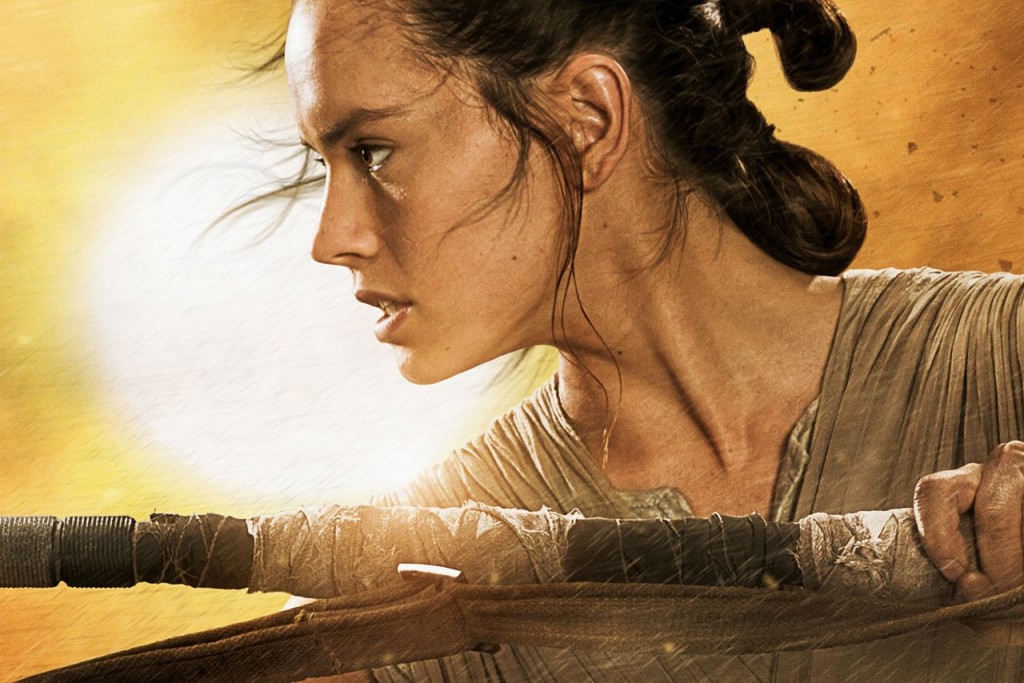YOU MAY HAVE HEARD of this little movie that came out earlier this year: Star Wars: The Force Awakens. Ring any bells? The latest installment in the franchise has made over $800 million domestically, but is projected to make as much as $8 billion in 2016 through Star Wars merchandise. In fact, Star Wars has historically always made most of its money through merchandise, so it was no surprise to Hasbro, the toy company that produces the Star Wars action figures and Monopoly game, that the release of The Force Awakens was going to mean a huge financial gain. Unfortunately, what Disney and Hasbro failed to anticipate was that people might actually be interested in the new female character, Rey, since they failed to release a Rey action figure or Star Wars Monopoly game piece. Rey is actually missing from a lot of the Star Wars merchandise that’s been released. Which makes sense — I mean, who would want to play with a girl action figure? Or who would want to play as a girl in a competitive money game?
Did Hasbro forget what year we’re living in? Even Canadian Prime Minister Justin Trudeau, when asked last year why he brought on an equal amount of women and men onto his cabinet, replied: “Because it’s 2015.” It is pretty outrageous, actually, for Hasbro to miss the mark by such a huge margin on this opportunity. If the lead character of the new movie is a woman, why would Hasbro think that fans wouldn’t want to play with toys modeled after her, especially after all the positive buzz she’s been receiving and continues to receive? Because she’s female? Really? Or is it because they thought young women wouldn’t be interested in merch? Well, that’s a mistake too. Women have historically been the most valuable purchasing demographic, so there is no reason to think Star Wars merchandise would be an exception.
Almost immediately, fans came up with #WheresRay on social media to bring awareness to Disney, LucasFilm, and Hasbro that just because they might be shortsighted in the expectations of their consumer, the consumers are not. Four weeks after the movie was released, Star Wars merchandise flooded the markets and Rey dolls with light sabers were released. LucasFilm’s defense on the matter was: “…That filmmakers wanted to keep under wraps was that the Force awakens in Rey and she carries a lightsaber. We always planned a second wave of product after the movie’s release that would include secrets revealed in the movie.” That seems like a little bit of a stretch as a defense, since Rey’s character was revealed time and time again throughout trailers and teasers. No, she didn’t have a light saber, but her presence was clearly to inform the audience that the franchise was introducing a new character and that this character is central to the new arc. Even JJ Abrams, the director, had a different reaction to the snub: “It seems preposterous and wrong that the main character of the movie is not well-represented in what is clearly a huge piece of the ‘Star Wars’ world in terms of merchandising.” Nice try, LucasFilm/ Disney.
Moreover, this isn’t the first time Disney has been in hot water for the exclusion of strong females in their merchandising. Gamora from Guardians of the Galaxy and Black Widow from The Avengers franchise were both absent from the merchandising campaigns spearheaded by Marvel Studios, which is a Disney-owned company. According to an article written by a former Marvel employee, Disney allots money for the female merchandise market through Disney Princesses, but Marvel’s merchandising is categorized through male merchandising markets only. Before Disney’s acquisition of Marvel, Marvel even had their own female merchandising line called HERoes, whose sweatshirts featured such empowering statements like “My Boyfriend is a Superhero.” No wonder it didn’t take off. You would think Marvel’s marketing team — and by extension Disney — would have learned the valuable lesson that young women don’t want their boyfriends to be heroes but that they want to be the heroes. However, the way Disney allocates its budgets proves that it hasn’t. Females are princesses and males are superheroes and that’s how it’s supposed to be, dammit!
Now that Hasbro has released more Rey character pieces, Star Wars merchandise focused on her character has sold out three times as fast as the other merchandise — which feels like both a good thing and a bad thing to me. Of course, it is amazing to prove these huge conglomerates wrong by unequivocally demonstrating that there’s a desire for and interest in this character. However, I am the type of person who goes on strike by not supporting companies who do not in turn support positive role models or images for women. Part of me wants us to go on “strike,” so to speak, and not give Disney any more money for creating a gender bias we are working so hard to fight every day. I know that’s a tall order, especially for something like Star Wars. So, while we haven’t solved this problem and forcing these these types of companies to update their outdated and sexist views isn’t going to happen over night, I am thankful for the power of social media and the fact that a trending hashtag can garner the attention of the top people who have control over these decisions. If Rey represents young women everywhere, slowly changing the face of gender equality and becoming their own superheroes, well then, #WheresRey? She’s on her way!




-300x169.jpg)












